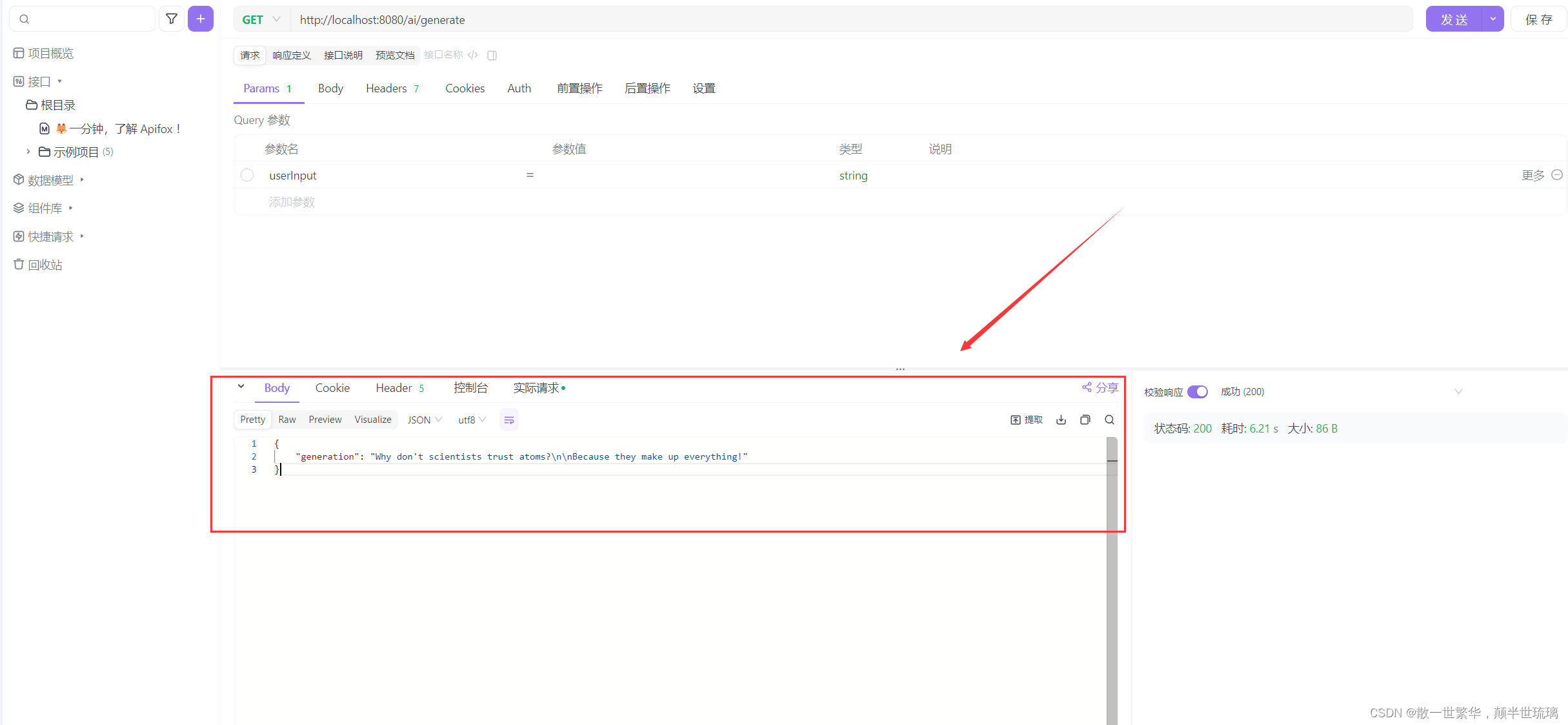1.SpringAI介绍
SpringAI是AI工程师的一个应用框架,它提供了一个友好的API和开发AI应用的抽象,旨在简化AI应用的开发工序。
目标是将可移植性和模块化设计等设计原则应用于AI领域的Spring生态系统,并将POJO作为应用程序的构建块推广到AI领域。
跨AI提供商的便携API支持聊天、文本到图像和嵌入模型。同时支持同步和流API选项。还支持各种定制的功能。
总的来说就是:Spring出了一个AI框架,帮助我们快速调用AI,从而实现各种功能场景。SpringAI官网链接

2.创建SpringBoot项目
-
打开IDEA新建一个项目或者模块;
-
在新出的弹框中选择Spring Boot;这里需要注意类型选择Maven、JDK需要选择17版本,打包方式选择jar;

-
选择需要添加的依赖项目,分别是SpringWeb和OpneAI;

-
最后点击创建即可。
3.修改仓库地址
项目创建完毕后,如果你的项目仓库地址是阿里云镜像,则有可能导致openai依赖无法正常下载,因此需要修改pom.xml中的仓库地址。具体如下所示:
<repositories><repository><id>spring-milestones</id><name>Spring Milestones</name><url>https://repo.spring.io/milestone</url><snapshots><enabled>false</enabled></snapshots></repository><repository><id>spring-snapshots</id><name>Spring Snapshots</name><url>https://repo.spring.io/snapshot</url><snapshots><enabled>false</enabled></snapshots></repository></repositories>
4.修改配置文件
spring.application.name=SpringAI-demo# 添加openai配置文件
spring.ai.openai.api-key=
spring.ai.openai.base-url=
spring.ai.openai.chat.options.model=gpt-3.5-turbo
spring.ai.openai.chat.options.temperature=0.7
这些配置项是用于Spring AI框架与OpenAI API集成的配置参数。以下是对每个配置项的详细解释:
1. spring.ai.openai.api-key
- 解释:这个配置项用于指定与OpenAI API通信的API密钥。API密钥是一个私密的字符串,OpenAI使用它来识别和授权您的应用程序。
- 示例:
spring.ai.openai.api-key=sk-XXXXXXXXXXXXXX
2. spring.ai.openai.base-url
- 解释:这个配置项用于指定OpenAI API的基础URL。通常,您可以使用默认的OpenAI URL,但在某些情况下,您可能需要指定一个自定义URL(例如,使用代理或自托管的OpenAI实例)。
- 示例:
spring.ai.openai.base-url=https://api.openai.com/v1
3. spring.ai.openai.chat.options.model
- 解释:这个配置项用于指定要使用的OpenAI模型的名称。OpenAI提供了多种模型,每种模型具有不同的性能和用途。例如,
gpt-3.5-turbo是一个性能良好且性价比高的模型,适合大多数对话和生成任务。 - 示例:
spring.ai.openai.chat.options.model=gpt-3.5-turbo
4. spring.ai.openai.chat.options.temperature
- 解释:这个配置项用于设置生成文本时的“温度”参数。温度控制生成文本的随机性。较高的温度值(如0.9)会使输出更随机和多样化,而较低的温度值(如0.2)会使输出更确定和集中。0.7是一个常用的平衡值。
- 示例:
spring.ai.openai.chat.options.temperature=0.7
5.编写控制层代码
1.Chat Client AI
package com.xing.springaidemo.controller;
import org.springframework.ai.chat.client.ChatClient;
import org.springframework.web.bind.annotation.GetMapping;
import org.springframework.web.bind.annotation.RestController;@RestController
public class ChatController {private final ChatClient chatClient;public ChatController(ChatClient.Builder chatClientBuilder) {this.chatClient = chatClientBuilder.build();}@GetMapping("/hello")public String hello() {return "Hello SpringAI";}@GetMapping("/ai")String generation(String userInput) {return this.chatClient.prompt().user(userInput).call().content();}
}
2.Chat Model AI
package com.xing.springaidemo.controller;import org.springframework.ai.openai.OpenAiChatModel;
import org.springframework.beans.factory.annotation.Autowired;
import org.springframework.web.bind.annotation.GetMapping;
import org.springframework.web.bind.annotation.RequestParam;
import org.springframework.web.bind.annotation.RestController;import java.util.Map;@RestController
public class ChatController {private final OpenAiChatModel model;@Autowiredpublic ChatController(OpenAiChatModel model) {this.model = model;}@GetMapping("/hello")public String hello() {return "Hello SpringAI";}@GetMapping("/ai/generate")public Map generate(@RequestParam(value = "message", defaultValue = "Tell me a joke") String message) {return Map.of("generation", model.call(message));}
}6.查看效果


)

)





:数据过滤)



 气泡聊天对话框)




)
![[C++] vector list 等容器的迭代器失效问题](http://pic.xiahunao.cn/[C++] vector list 等容器的迭代器失效问题)